The history of the Church of Jesus Christ of Latter-day Saints has three main periods, described generally as:
- the early history during the lifetime of Joseph Smith, which is in common with most Latter Day Saint movement churches;
- the "pioneer era" under the leadership of Brigham Young and his 19th-century successors;
- the modern era beginning in the early 20th century as the practice of polygamy was discontinued and many members sought reintegration into U.S. society.

"The Family: A Proclamation to the World" is a 1995 statement issued by the Church of Jesus Christ of Latter-day Saints which defined the official position of the church on family, marriage, gender roles, and human sexuality. It was first announced by church president Gordon B. Hinckley.
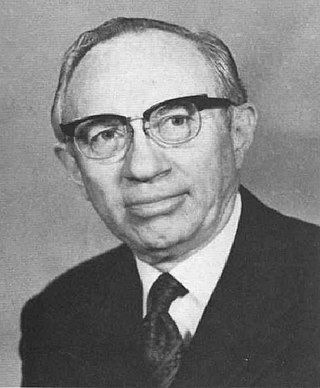
Gordon Bitner Hinckley was an American religious leader and author who served as the 15th president of the Church of Jesus Christ of Latter-day Saints from March 1995 until his death in January 2008 at age 97. Considered a prophet, seer, and revelator by church members, Hinckley was the oldest person to preside over the church in its history until Russell M. Nelson surpassed his age in 2022.
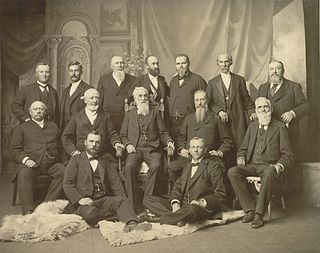
In the Church of Jesus Christ of Latter-day Saints, the Quorum of the Twelve Apostles is one of the governing bodies in the church hierarchy. Members of the Quorum of the Twelve Apostles are apostles, with the calling to be prophets, seers, and revelators, evangelical ambassadors, and special witnesses of Jesus Christ.
In the Church of Jesus Christ of Latter-day Saints, the Priesthood Correlation Program began in 1908 as a program to reform the instruction manuals and curriculum of the different organizations of the church. Its scope quickly widened, and Correlation came to affect almost every aspect of the church, including doctrines, organizations, finances, and ordinances. A significant consequence was to centralize decision-making power in the priesthood, particularly the Quorum of the 12 Apostles. More recently, the function of the correlation department has shifted to planning and approving church publications and curriculum and keeping unorthodox information, doctrines, and other undesired concepts from being introduced or revived.

Sacrament meeting is the primary weekly Sunday worship service in the Church of Jesus Christ of Latter-day Saints.
Thomas Baldwin Marsh was an early leader in the Latter-day Saint movement and an original member of the Quorum of the Twelve Apostles, who served as the quorum's first president in the Church of the Latter Day Saints from 1835 to 1838. He withdrew from the church in 1838, was excommunicated from it in 1839, and remained disaffected for almost 19 years. Marsh was rebaptized into the Church of Jesus Christ of Latter-day Saints in July 1857, but never again served in church leadership positions.

Family Home Evening (FHE) or Family Night, in the context of the Church of Jesus Christ of Latter-day Saints, refers to one evening per week, usually Monday, that families are encouraged to spend together in religious instruction, prayer and other activities. According to the LDS Church, the purpose of FHE is to help families strengthen bonds of love with each other as well as provide an atmosphere where parents can teach their children principles of the gospel.

In the Latter Day Saint movement, a temple is a building dedicated to being a house of God and is reserved for special forms of worship. A temple differs from a church meetinghouse, which is used for weekly worship services. Temples have been a significant part of the Latter Day Saint movement since early in its inception. Today, temples are operated by several Latter Day Saint denominations. The most prolific builder of temples of the Latter Day Saint movement is the Church of Jesus Christ of Latter-day Saints. The LDS Church has 367 temples in various phases, which includes 197 dedicated temples, 5 scheduled for dedication, 49 under construction, 1 scheduled for groundbreaking, and 115 others announced. Several others within the movement have built or attempted to build temples. The Community of Christ operates one temple in the United States, which is open to the public and used for worship services, performances, and religious education. Other denominations with temples are the Apostolic United Brethren, the Church of Christ, the Fundamentalist Church of Jesus Christ of Latter-Day Saints, and the Righteous Branch of the Church of Jesus Christ of Latter-day Saints.
This is a timeline of major events in Mormonism in the 20th century.
Worship services of the Church of Jesus Christ of Latter-day Saints include weekly services held in meetinghouses on Sundays in geographically based religious units. Once per month, this weekly service is a fast and testimony meeting. Twice each year, the LDS Church holds a worldwide general conference. LDS Church adherents also worship in temples, which are open only to members in good standing.
In Mormonism, revelation is communication from God to man. Latter Day Saints teach that the Latter Day Saint movement began with a revelation from God, which began a process of restoring the gospel of Jesus Christ to the earth. Latter Day Saints also teach that revelation is the foundation of the church established by Jesus Christ and that it remains an essential element of his true church today. Continuous revelation provides individual Latter Day Saints with a "testimony", described by Richard Bushman as "one of the most potent words in the Mormon lexicon".
Sunday School is an organization of the Church of Jesus Christ of Latter-day Saints. All members of the church and any interested nonmembers, age 11 and older, are encouraged to participate in Sunday School.

In the Latter Day Saint movement, baptism is recognized as the first of several ordinances (rituals) of the gospel.
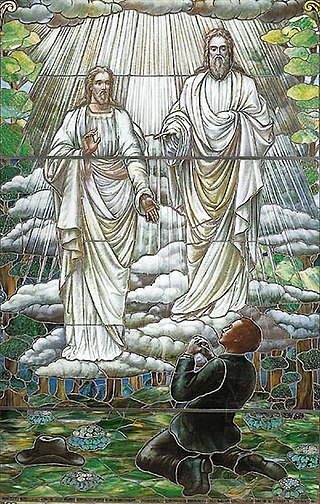
The Church of Jesus Christ of Latter-day Saints focuses its doctrine and teaching on Jesus Christ; that he was the Son of God, born of Mary, lived a perfect life, performed miracles, bled from every pore in the Garden of Gethsemane, died on the cross, rose on the third day, appeared again to his disciples, and now resides, authoritatively, on the right hand side of God. In brief, some beliefs are in common with Catholics, Orthodox and Protestant traditions. However, teachings of the LDS Church differ significantly in other ways and encompass a broad set of doctrines, so that the above-mentioned denominations usually place the LDS Church outside the bounds of orthodox Christian teaching as summarized in the Nicene Creed.

In the Church of Jesus Christ of Latter-day Saints, a temple is a building dedicated to be a House of the Lord. Temples are considered by church members to be the most sacred structures on earth.

The Church of Jesus Christ of Latter-day Saints in Wales refers to the Church of Jesus Christ of Latter-day Saints and its members in Wales.
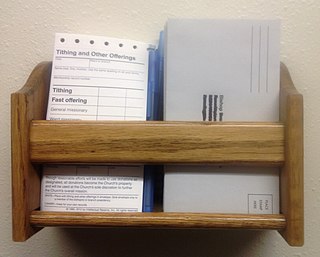
Tithing is a commandment accepted by various churches in the Latter Day Saint movement. In practicing tithing, adherents make willing tithe donations, usually ten percent of their income, to their church. It is based on both the biblical practice of paying tithes and modern revelation given to Joseph Smith and his accepted successors. For many of these churches, the law of tithing replaced or supplemented the law of consecration. The Church of Jesus Christ of Latter-day Saints emphasized tithing in the 1900s and 1960s to assist in paying church debts.
Apostolic succession in the Church of Jesus Christ of Latter-day Saints is the process of transition to a new church president when the preceding one has died.
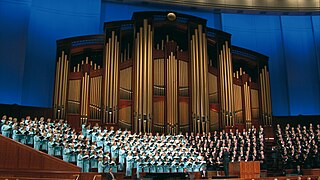
General Conference is a gathering of members of the Church of Jesus Christ of Latter-day Saints, held biannually every April and October at the Conference Center in Salt Lake City, Utah. During each conference, church members gather in a series of two-hour sessions to listen to the faith's leaders.











